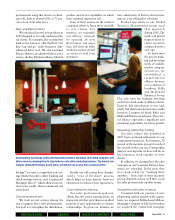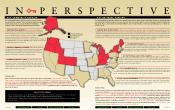KeyBank 2005 Annual Report Download - page 16
Download and view the complete annual report
Please find page 16 of the 2005 KeyBank annual report below. You can navigate through the pages in the report by either clicking on the pages listed below, or by using the keyword search tool below to find specific information within the annual report.
15
MANAGEMENT’S DISCUSSION & ANALYSIS OF FINANCIAL CONDITION & RESULTS OF OPERATIONS KEYCORP AND SUBSIDIARIES
to a nonimpaired loan is much more subjective. Generally, the allowance
assigned to nonimpaired loans is determined by applying historical
loss rates to existing loans with similar risk characteristics and by
exercising judgment to assess the impact of factors such as changes
in economic conditions, changes in credit policies or underwriting
standards, and changes in the level of credit risk associated with specific
industries and markets. Because the economic and business climate in
any given industry or market, and its impact on a particular borrower,
are difficult to gauge and can change rapidly, the risk profile of the loan
portfolio is continually assessed and adjusted when appropriate.
Notwithstanding these procedures, it is still possible for management’s
assessment to be significantly incorrect, requiring an immediate
adjustment to the allowance for loan losses.
Adjustments to the allowance for loan losses can materially affect net
income. Such adjustments may result from events that cause actual
losses to vary abruptly and significantly from expected losses. For
example, class action lawsuits brought against an industry segment
(e.g., one that utilized asbestos in its product) can cause a precipitous
deterioration in the risk profile of borrowers doing business in that
segment. Conversely, the dismissal of such lawsuits can cause a significant
improvement in the risk profile. In either case, historical loss rates for
that industry segment would not have provided a precise basis for
determining the appropriate level of allowance.
Because Key’s loan portfolio is large, even minor changes in estimated loss
rates can significantly affect management’s determination of the appropriate
level of allowance. For example, a one-tenth of one percent change in the
loss rate assumed for Key’s December 31, 2005, consumer loan portfolio
would result in a $20 million change in the level of allowance deemed
appropriate. The same percentage change in the loss rate assumed for the
commercial loan portfolio would result in a $46 million change in the
allowance. If these changes had actually occurred in 2005, they could have
reduced Key’s net income by approximately $13 million, or $.03 per share,
and $29 million, or $.07 per share, respectively.
Management estimates the appropriate level of Key’s allowance by
conducting a detailed review of a significant number of much smaller
portfolio segments that make up the consumer and commercial loan
portfolios. Since Key’s total loan portfolio is well diversified in many
respects, a change in the level of the allowance for one segment of the
portfolio does not necessarily mean that a change is appropriate for any
other segment. Also, the risk profile of certain segments of the loan
portfolio may be improving, while the risk profile of others may be
deteriorating. As a result, changes in the appropriate level of the
allowance for different segments may offset each other.
Our accounting policy related to the allowance is disclosed in Note 1
under the heading “Allowance for Loan Losses” on page 59.
Loan securitizations. Key securitizes certain types of loans, and accounts
for those transactions as sales when the criteria set forth in Statement of
Financial Accounting Standards (“SFAS”) No. 140, “Accounting for
Transfers and Servicing of Financial Assets and Extinguishments of
Liabilities,” are met. If future events were to preclude accounting for
such transactions as sales, the loans would have to be brought back onto
Key’s balance sheet, which could have an adverse effect on Key’s capital
ratios and other unfavorable financial implications.
In addition, management must make assumptions to determine the
gain or loss resulting from securitization transactions and the subsequent
carrying amount of retained interests; the most significant of these are
described in Note 8 (“Loan Securitizations, Servicing and Variable
Interest Entities”), which begins on page 70. Note 8 also includes
information concerning the sensitivity of Key’s pre-tax earnings to
immediate adverse changes in important assumptions. The use of
alternative assumptions would change the amount of the initial gain or
loss recognized and might result in changes in the carrying amount of
retained interests, with related effects on results of operations. Our
accounting policy related to loan securitizations is disclosed in Note 1
under the heading “Loan Securitizations” on page 59.
Contingent liabilities, guarantees and income taxes. Contingent
liabilities arising from litigation, guarantees in various agreements with
third parties under which Key is a guarantor, and the potential effects
of these items on Key’s results of operations are summarized in Note 18
(“Commitments, Contingent Liabilities and Guarantees”), which begins
on page 83. In addition, it is not always clear how the Internal Revenue
Code and various state tax laws apply to transactions undertaken by Key.
In the normal course of business, Key may record tax benefits related to
transactions, and then find those benefits contested by the Internal
Revenue Service and/or state tax authorities. Key has provided tax
reserves that management believes are adequate to absorb potential
adjustments that such challenges may necessitate. For further information
on Key’s accounting for income taxes, see Note 17 (“Income Taxes”),
which begins on page 82.
Key records a liability for the fair value of the obligation to stand
ready to perform over the term of a guarantee, but there is a risk that
Key’s actual future payments in the event of a default by a third party
could exceed the liability recorded on Key’s balance sheet. See Note 18
for a comparison of the liability recorded and the maximum potential
undiscounted future payments for the various types of guarantees that
Key had outstanding at December 31, 2005.
Valuation methodologies. Valuation methodologies often involve a
significant degree of judgment, particularly when there are no observable
liquid markets for the items being valued. The outcomes of valuations
performed by management have a direct bearing on the carrying
amounts of assets and liabilities, including principal investments,
goodwill, and pension and other postretirement benefit obligations.
To determine the values of these assets and liabilities, as well as the
extent to which related assets may be impaired, management makes
assumptions and estimates related to discount rates, asset returns,
prepayment rates and other factors. The use of different discount rates
or other valuation assumptions could produce significantly different
results, which could affect Key’s results of operations.
Key’s principal investments include direct and indirect investments,
predominantly in privately held companies. The fair values of these
investments are estimated by considering a number of factors, including
the investee’s financial condition and results of operations, values of
public companies in comparable businesses, market liquidity, and the
nature and duration of resale restrictions. Due to the subjective nature
of the valuation process, it is possible that the actual fair values of these
investments could differ from the estimated amounts, thereby affecting
NEXT PAGEPREVIOUS PAGE SEARCH BACK TO CONTENTS
























